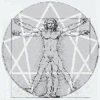“From this point of view, then, the world consists of VIBRATIONs and matter, or of matter in a state of VIBRATION, of vibrating matter. The rate of VIBRATION is in inverse ratio to the density of matter. Fragments: Five
“In this connection according to the usual views accepted in the West, VIBRATIONs are continuous. This means that VIBRATIONs are usually regarded as proceeding uninterruptedly, ascending or descending so long as there continues to act the force of the original impulse which caused the VIBRATION and which overcomes the resistance of the medium in which the VIBRATIONs proceed. When the force of the impulse becomes exhausted and the resistance of the medium gains the upper hand the VIBRATIONs naturally die down and stop. But until this moment is reached, that is, until the beginning of the natural weakening, the VIBRATIONs develop uniformly and gradually, and, in the absence of resistance, can even be endless. So that one of the fundamental propositions of our physics is the continuity of VIBRATIONs, although this has never been precisely formulated because it has never been opposed. In certain of the newest theories this proposition is beginning to be shaken. Nevertheless physics is still very far from a correct view on the nature of VIBRATIONs, or what corresponds to our conception of VIBRATIONs, in the real world. Fragments: Seven
“The principle of the discontinuity of VIBRATION means the definite and necessary characteristic of all VIBRATIONs in nature, whether ascending or descending, to develop not uniformly but with periodical accelerations and retardations. This principle can be formulated still more precisely if we say that the force of the original impulse in VIBRATIONs does not act uniformly but, as it were, becomes alternately stronger and weaker. The force of the impulse acts without changing its nature and VIBRATIONs develop in a regular way only for a certain time which is determined by the nature of the impulse, the medium, the conditions, and so forth. But at a certain moment a kind of change takes place in it and the VIBRATIONs, so to speak, cease to obey it and for a short time they slow down and to a certain extent change their nature or direction; for example, ascending VIBRATIONs at a certain moment begin to ascend more slowly, and descending VIBRATIONs begin to descend more slowly. After this temporary retardation, both in ascending and descending, the VIBRATIONs again enter the former channel and for a certain time ascend or descend uniformly up to a certain moment when a check in their development again takes place. In this connection it is significant that the periods of uniform action of the momentum are not equal and that the moments of retardation of the VIBRATIONs are not symmetrical. One period is shorter, the other is longer. Fragments: Seven
“If we begin with VIBRATIONs of world 48, we can say that one note of the VIBRATIONs in this world contains an octave or seven notes of the VIBRATIONs of the planetary world. Each note of the VIBRATIONs of the planetary world contains seven notes of the VIBRATIONs of the world of the sun. Each VIBRATION of the world of the sun will contain seven notes of the VIBRATIONs of the starry world and so on. Fragments: Seven

